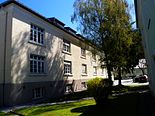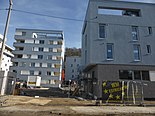Riedenburg barracks
The Riedenburg barracks was located in the Salzburg district of Riedenburg between Neutorstrasse, Moosstrasse, Sinnhubstrasse and Leopoldskronstrasse. The barracks area was over three hectares and comprised about twenty buildings and a bunker . In addition, the Neutorstrasse kindergarten, the publicly used Riedenburg sports hall and a building for the Salzburg Amateur Radio Association were located on the site. The Salzburg Defense History Museum was also housed there, and has moved to the Schwarzenberg barracks .
History of the Riedenburg barracks
The Riedenburg has a long history of defense. This area has been used by the Archbishop's military as a training ground or parade ground since the 16th century . In 1662 the shooting range of the Salzburg Rifle Society was relocated from Nonntal to Riedenburg in the Bucklreuth area; several state main shootings were held there. Even later (in 1859 for a few more years) the state main shooting range was housed in the Riedenburg barracks. Five wooden barracks were built by the Salzburg “landscape” (corresponds to today's state government) in 1730 as the first military buildings on the Riedenburg area for imperial troops marching through . These buildings were renewed in 1736 and converted into accommodation for 600 men and 230 horses; In the extended barracks area there was a parade ground on the northern slope of the Rainberg, a sutler's hut , a guardhouse and a "hospital".
When Salzburg was annexed to Austria, the camera operator took over the buildings in 1816 and left them to the military for free use. The military used these from 1816 to 1819 as a food store and temporarily as summer quarters for crew, recruits and vacationers. In 1831 the city magistrate was advised to provide other rooms for military supplies in kind in order to clear the barracks to accommodate 1,000 men of the Austro-Hungarian army , which was done immediately to free the city from annoying billeting. On October 28, 1889, the state committee of the Duchy of Salzburg decided to build the cavalry and artillery barracks "in the Riedenburg". Division No. 28, later the 41st Division Artillery Regiment, was housed in the command building. This was dissolved after Austria-Hungary surrendered at the end of October / November 1918. The Riedenburg barracks remained empty and orphaned for a while. Immediately next to the barracks area is today's kindergarten on Neutorstrasse in the former Weiznervilla (built in 1840/41).
During the 1st Republic in 1920, the mine-thrower battery 4 was housed in the barracks as a sub-unit of Brigade Artillery Department 6 of the Federal Army . This unit was renamed in 1926 in "Salzburger Feldkanonenbatterie" or "Feldkanonenbatterie l". In the course of the development of the Salzburg Festival, the Hofstall barracks owned by the armed forces was planned as the future festival hall and in 1922 it was exchanged for the Riedenburg barracks, which had previously been leased. In 1926 a covered riding hall was built between the open riding school grounds and Leopoldskronstrasse on the barracks site. Due to further developments, the barracks were expanded to 16 buildings by 1938.
After the takeover by the German Wehrmacht (1938–1945), a vehicle hall, a radio workshop, a gun shed and a team building were built in solid construction. Intelligence Corps 70, which had emerged from Intelligence Department 18 in 1939, was established in the barracks. The news corps stayed in the barracks until the end of the war. As the war continued, the barracks also housed a "convalescent company". In addition, it served as a training facility for the 2nd Company of the Mountain Intelligence Unit XVIII (GNA XVIII, radio company). In 1942 the barracks were occupied by 860 men, plus 150 men in the barracks across from Sinnhubstrasse.
After May 4, 1945, the barracks were confiscated by the USFA as "German property" and initially served as a release or transition camp for German soldiers. From June 1945 the barracks was used by the International Refugees Organization (IRO) as a refugee camp for Jewish “displaced persons” (DP) who wanted to travel to the USA or Palestine. Therefore, from 1947 to March 31, 1949, the barracks was called "Camp Juda". In addition, from 1945 to June 1949 the technical service ("fire protection police and technical emergency aid") was housed here. After the evacuation by the Jewish DPs and the renovation of the buildings, the barracks became the USFA's "Camp Riedenburg" (1949–1955). A military police company , a PX house and an auxiliary hospital were housed here. The riding hall (= covered riding school) was transformed into a sports hall (today's Riedenburger sports hall), in which basketball and boxing events took place. The USFA Club (the Jazz Club "Royal Roost") moved in 1948 to the former officers 'house or the commanders' villa (today the "state practice kindergarten").
On August 3, 1955, the facility was handed over to the armed forces of the 2nd Republic. On August 3, an advance detachment from the 3rd subdivision of the Tyrol II Gendarmerie School from Kufstein entered the barracks. Later the command of the newly established 8th Mountain Infantry Brigade was housed there. The gymnasium and kindergarten were separated from the barracks and dedicated to public use. Several team buildings were ceded to the Salzburg state government and leased to a commercial enterprise in 1956. In 1963 the brigade command became a military command, and in 1991 the barracks was renamed the “Riedenburg command building”. The Salzburg Military Command is the highest authority in the Federal Army at the regional level and is responsible for managing all military facilities in the state of Salzburg . It is the control center for disaster operations, responsible for supply and logistics in the event of an emergency and for coordinating the allocation of economic goods such as clothing or food. After the barracks site was sold, it moved to the Schwarzenberg barracks in Siezenheim in 2014.
Since its re-establishment in 1979, the area around the Riedenburg barracks has also served the Salzburg Citizens Guard as a parade ground. From 1992, the Salzburg Defense History Museum , which was opened to the public in 2004, was also housed here.
On October 30, 2012, the Riedenburg barracks was sold to housing associations by the Republic of Austria. between the non-profit Salzburger Wohnbaugesellschaft GSWB and UBM Realitätenentwicklung . The purchase price was 16 million euros. Then the Salzburg military command moved out or moved to the Schwarzenberg barracks in Wals-Siezenheim .
The Riedenburg sports hall was used as accommodation for refugees, especially those from the civil war in Syria , in the winter of 2015/16 . In the summer of 2016, it was demolished, as was most of the rest of the barracks. The bunker was also exposed and destroyed. The commander's villa remains.
Riedenburg district
An architecture museum ("Architekturhaus") is planned to be housed in a preserved building of the former barracks.
The housing cooperative GSWB (owned by the state and municipality of Salzburg) announced in 2012 that it wanted to build around 160 subsidized rental apartments on around 21,000 square meters and commercial space and apartments along Neutorstrasse; UBM Realitätenentwicklung AG is planning privately financed condominiums on around 5,400 square meters, and around 5,000 square meters are earmarked for gardens.
The teams of architects involved in the planning and construction of the "Quartiers Riedenburg" were awarded the German Design Award by the German Design Council on February 7, 2020 , and the participating architects were also awarded the 13th International Design Award (IDA 2019) in the category "Architecture - Low cost Housing" was awarded silver and in the category "Architecture - Urban Design" bronze.
See also
literature
- Hans Bayr: The beginnings of the Austrian Armed Forces in the state of Salzburg. In: Hans Bayr et al. (Ed.): Salzburg 1945–1955. Destruction and rebuilding. Salzburger Museum Carolino Augusteum, Salzburg 1995, ISBN 3-901014-43-8 , pp. 275-287.
- Gerhard F. Fasching, Otto H. Rainer: The dislocation of the US armed forces from 1945 to 1955 in Salzburg. In: Hans Bayr et al. (Ed.): Salzburg 1945–1955. Destruction and rebuilding. Salzburg Museum Carolino Augusteum, Salzburg 1995, ISBN 3-901014-43-8 , pp. 289–321.
Web links
Individual evidence
- ↑ gswb and UBM buy Riedenburg barracks . Press release of the gswb, October 30, 2012.
- ^ Price for the Riedenburg district. City Gazette Salzburg, 19./20. February 2020.
Coordinates: 47 ° 47 '47.75 " N , 13 ° 1' 49.58" E













